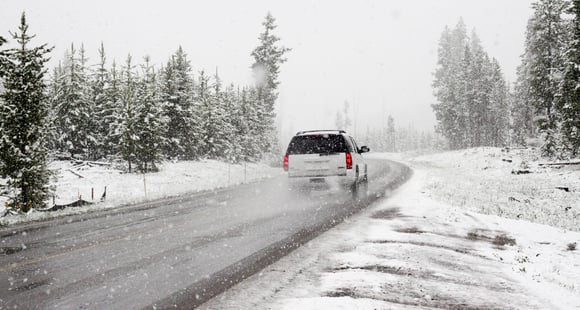Each year, winter weather causes nearly 76,000 injuries in car accidents. Black ice, snow, and wet roads can result in dangerous situations for drivers that dramatically increase the risk for a collision. Additionally, poor road conditions and a higher volume of calls can strain emergency services and result in slower response times. The best way to prevent accidents is to avoid driving in snowy or icy conditions unnecessarily, however if you absolutely must drive, here are 5 winter driving safety tips.

1. Know your vehicle
Take time to get to know your vehicle. Understand the effectiveness of your brakes and steering, check what driver assist systems may be installed on your vehicle and how to use them. Determine if your vehicle is front, rear, or all wheel drive, and take some time to have the vehicle’s brakes, tires, and fluids checked. Understanding your vehicle’s capabilities and limitations is key to mastering driving on any road conditions.
2. Maintain Traction
After taking the time to get to know your vehicle, you may find that there are several built-in features that will help you maintain traction in wintery conditions. One such feature is electronic traction control. This feature uses sensors to monitor your wheel speed. If one or more wheels begin to slip and spin faster than the others, the system automatically applies the brakes to the slipping wheel(s) and decreases engine power. Traction control is enabled by default, and notifies you that it is working when a wheel slips by a flashing light on your instrument panel. If the light begins flashing, maintain your throttle until the light stops flashing. As a reminder, traction control doesn’t defeat the laws of physics; accelerate and decelerate gently and consistently, and avoid accelerating on hills to prevent a loss of traction.
3. Do not pump your brakes with ABS!
There’s a common myth around pumping your brakes in the snow. Older vehicles did require drivers to pump the brakes in the snow to prevent the wheels from locking up. That’s no longer the case, as nearly all newer cars are equipped with ABS (anti-lock braking system). This system prevents wheels from locking under heavy braking by pumping the brakes very quickly so that you don’t have to. If your vehicle is equipped with ABS, do not pump the brakes while stopping in snow or ice. Simply depress the pedal as far as possible, and allow the ABS to work.

4. Slow down.
Snow and ice reduce traction, and greatly increase the distance needed to come to a stop. It’s best keep your speed 5-10 miles per hour slower than the posted speed limit and maintain roughly double your typical distance between your car and the car ahead of you. While keeping your speed down is helpful, it isn’t all you need to slow down. Plan ahead to avoid quick maneuvers like sudden, aggressive steering, harsh acceleration, and sudden braking. Failing to avoid these can cause your vehicle to lose traction, and lead to losing control.
5. Tires are everything!
No matter what type of car you drive, how many safety features it may have, or even if it’s equipped with four wheel drive, it will all be for naught if your tire tread is wearing down or you’re driving on Summer tires. If you live in a more mild climate that receives snow or ice occasionally, all season tires may be your best solution. A set of all seasons can be used no matter the climate, and offer much better traction in snow than summer tires. To be certain you’re getting the most traction you can, or if you live in a climate that brings frequent snow and ice, designated snow tires are ideal. These are recommended for winter driving only, and provide the most traction in snow.
Again, if it isn’t necessary, don’t drive in snowy or icy conditions. If you do drive, be sure you know your vehicle, and it’s prepared with functional brakes and appropriate tires. Drive slowly and cautiously, avoiding harsh maneuvers, and plan ahead. After the weather’s passed and your car’s looking a bit salty, be sure to skip the lines at the car wash with your Spiffy app!
Most people know salt is corrosive and can cause cosmetic issues for cars, but don’t forget about the salt on the undercarriage of your vehicle, where many of your vehicle’s vitals are exposed.
Don't be salty. For a limited time, we are offering a free Undercarriage Turbo Clean with purchase of a wash or detail! Just choose the free upgrade in the Spiffy App when you book your service. Offer valid through Sunday, December 17th.





